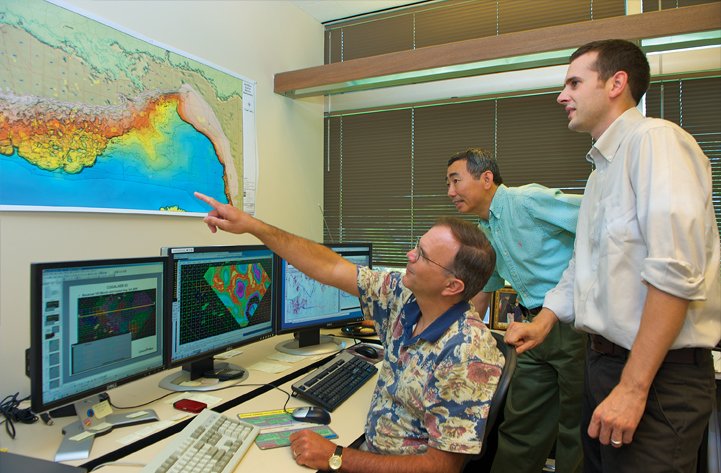All Categories
Featured
Table of Contents
Geophysical Engineering Undergraduate Program in Scarborough Oz 2020

(PREM)., and the limits between layers of the mantle are consistent with phase transitions.

Schematic of Earth's magnetosphere. Flows from left to.
Inside the magnetosphere, there are relatively thick regions of solar wind particles called the Van Allen radiation belts. Geophysical measurements are normally at a particular time and place.
Geophysicist Job Description in Madeley Oz 2021
A three-dimensional position is calculated utilizing messages from four or more visible satellites and described the 1980 Geodetic Referral System. An alternative, optical astronomy, integrates astronomical coordinates and the local gravity vector to get geodetic coordinates. This method only offers the position in two collaborates and is harder to utilize than GPS.
Relative positions of two or more points can be figured out utilizing very-long-baseline interferometry. Gravity measurements entered into geodesy due to the fact that they were needed to related measurements at the surface of the Earth to the reference coordinate system. Gravity measurements on land can be used gravimeters deployed either on the surface area or in helicopter flyovers.
Satellites in space have actually made it possible to collect data from not just the noticeable light area, however in other areas of the electro-magnetic spectrum. The worlds can be characterized by their force fields: gravity and their magnetic fields, which are studied through geophysics and space physics. Measuring the changes in acceleration experienced by spacecraft as they orbit has actually enabled great information of the gravity fields of the planets to be mapped.
Geophysical Survey Services in Bellevue Aus 2021

Since geophysics is worried about the shape of the Earth, and by extension the mapping of functions around and in the planet, geophysical measurements consist of high precision GPS measurements. These measurements are processed to increase their precision through differential GPS processing. When the geophysical measurements have been processed and inverted, the analyzed outcomes are outlined using GIS.
Numerous geophysics companies have developed internal geophysics programs that pre-date Arc, GIS and Geo, Soft in order to satisfy the visualization requirements of a geophysical dataset. Exploration geophysics is applied geophysics that typically utilizes remote sensing platforms such as; satellites, aircraft, ships, boats, rovers, drones, borehole sensing devices, and seismic receivers.
Aeromagnetic data (aircraft collected magnetic data) gathered using conventional fixed-wing aircraft platforms should be remedied for electromagnetic eddy currents that are created as the airplane moves through Earth's electromagnetic field. There are likewise corrections associated with modifications in measured possible field strength as the Earth turns, as the Earth orbits the Sun, and as the moon orbits the Earth.
Geophysics Jobs in Bellevue Australia 2020
Signal processing involves the correction of time-series data for unwanted sound or mistakes presented by the measurement platform, such as airplane vibrations in gravity data. It also includes the reduction of sources of sound, such as diurnal corrections in magnetic data. In seismic information, electro-magnetic information, and gravity data, processing continues after error corrections to consist of computational geophysics which result in the final interpretation of the geophysical data into a geological analysis of the geophysical measurements Geophysics emerged as a different discipline just in the 19th century, from the intersection of physical location, geology, astronomy, meteorology, and physics.
The magnetic compass existed in China back as far as the 4th century BC. It was utilized as much for feng shui when it comes to navigation on land. It was not up until excellent steel needles could be forged that compasses were used for navigation at sea; before that, they could not maintain their magnetism enough time to be useful.
By looking at which of eight toads had the ball, one could determine the instructions of the earthquake.'s (1600 ), a report of a series of meticulous experiments in magnetism.
Glad You Asked: What Are Seismic Surveys? in Hocking Oz 2020
Dietmar; Sdrolias, Maria; Gaina, Carmen; Roest, Walter R. (April 2008). "Age, spreading out rates, and spreading out asymmetry of the world's ocean crust". Geochemistry, Geophysics, Geosystems. 9 (4 ): Q04006. Bibcode:2008 GGG ... 9. 4006M. doi:10. 1029/2007GC001743. S2CID 15960331. "Earth's Inconstant Magnetic Field". science@nasa. National Aeronautics and Space Administration. 29 December 2003. Recovered 13 November 2018.
Runcorn, S.K, (editor-in-chief), 1967, International dictionary of geophysics:. Pergamon, Oxford, 2 volumes, 1,728 pp., 730 fig Geophysics, 1970, Encyclopaedia Britannica, Vol. Introduction to seismology (Second ed.).
Latest Posts
Geophysical Surveys - U.s. Geological Survey in Wandi Western Australia 2023
Geophysics in Mount Claremont Aus 2020
Geophysical Survey in Casaurina Aus 2020